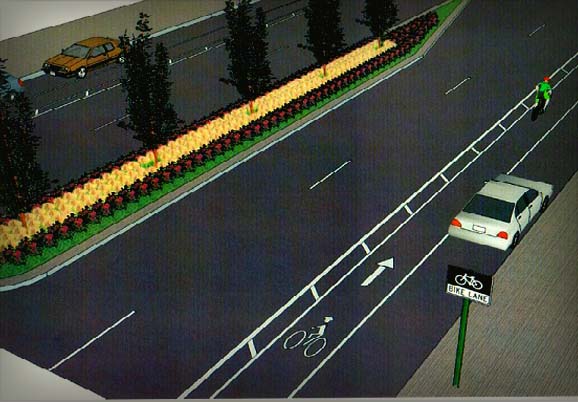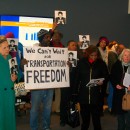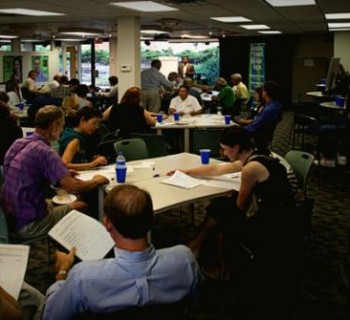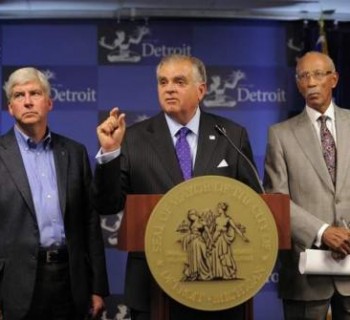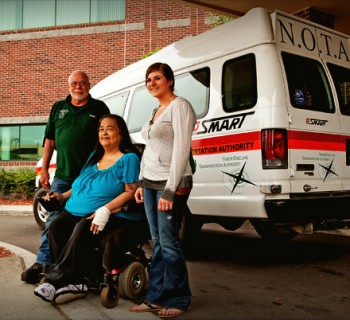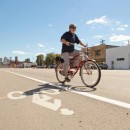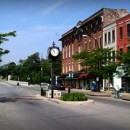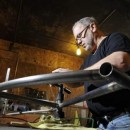DETROIT—Jefferson Avenue can sometimes feel like a turbulent sea of cars, one that can be especially rough for bicyclists and pedestrians. An effort is now under way, however, to turn a stretch of the busy thoroughfare into calmer waters for non-motorized travelers.
The development group Jefferson East, Inc. is working with the city of Detroit and other partners to add protected bike lanes and other street enhancements to about a third of a mile of the corridor between the border of Grosse Pointe Park at Alter Road and Lakewood Street, a block past Chalmers in Detroit. Their plans are geared towards making the area both safer and more appealing.
The project would reconfigure wide, combination travel-parking lanes on both sides of the road. Plans call for each of these to be converted into a dedicated parking lane and a five-foot bike lane with a two-foot painted buffer lane, reducing the total number of travel lanes from three to two in each direction.
In addition, short turn bays in the middle of Chalmers' northbound and southbound lanes will be transformed into a northbound-only turn lane on Jefferson. Traffic calming islands with turn lanes are also in the works for several of the busier intersections along the corridor.
Construction from Alter to Lakewood is slated for this summer, with plans for additional improvements in 2015.
Re-striping the Alter to Lakewood stretch will take place this summer with with further re-striping planned for next year.
"We are working on re-striping that would continue west [and eventually] take you back to back to the Connor Creek Greenway and the wider greenway network there," Justin Fried, Jefferson East, Inc.'s corridor revitalization rirector and a Detroit Revitalization Fellow, told Mode Shift. "Eventually, we're wanting to continue west and make improvements along the entire east Jefferson corridor."
Between 2009 and 2010, Fried's organization put together a conceptual framework for renovating the entire length of East Jefferson. Right now it's focusing on raising money for additional re-striping to extend the bike lanes west to East Grand Boulevard and to connect them with Belle Isle and the Detroit RiverWalk. Jefferson East also wants to add extra landscaped islands at several key intersections to make crossing easier for pedestrians.
It's also participating in a study of I-375 looking into alternatives that could transform the freeway into a pedestrian-friendly boulevard. Changes to the expressway would alter traffic patterns on East Jefferson in the city's Rivertown district, potentially affecting the future streetscape in that part of the corridor.
The City of Detroit has agreed to handle the re-striping for the current project area, while Jefferson East, Inc. is partnering with the Detroit Eastside Community Collaborative to cover the design work between Lakewood and St. Jean. Giffels Webster is the engineering firm currently working on the project.

The Michigan Department of Transportation and the Southeast Michigan Council of Governments are helping fund the effort with a grant from the state's Transportation Alternatives Program. Although the rough outlines of the roadwork have been sketched out details are still being reviewed by MDOT.
Fried's organization, formerly the Jefferson East Business Association and the Jefferson East Corridor Collaborative, has been looking into the renovations for about half a decade.
"The goal is to really make it a multimodal complete street, but you have a lot of through traffic on Jefferson Avenue," said Fried. "You have a road width to work with, but with the commercial district we're in as well as a lot of cross-streets ..., they looked at a lot of design options. The on-street lane with the protected buffer took best advantage of the width that we had without compromising the commercial access and the parking."
In preparation for the road work, Wayne State University's Transportation Research Group studied traffic along the entire east Jefferson corridor for a three-year period between 2009 and 2011.
According to their analysis, about 1,300 vehicles drive along the project area during peak morning and evening hours on the average day. Fried said this makes it the lowest traffic volume along the corridor, but safety is still very much an issue.
The WSU study found that the Jefferson-Chalmers intersection had the most vehicle-pedestrian accidents on East Jefferson during that time, three out of a total of 10 incidents. What's more, it determined that the Chalmers-to-Alter stretch had the third highest amount of vehicle accidents along the corridor, outranked only by Rivard to St. Aubin and Mt. Elliot to Grand Boulevard.
Due to the presence of bus riders and school children on the route, safety has been the prime project concern for Jefferson East, Inc., but the development group also hopes the changes will bring more foot traffic to the area.
Fried believes the road redevelopment will build on other efforts to revitalize the Jefferson Chalmers commercial district, like bringing new businesses to the strip and hosting a series of pop-ups in collaboration with a local jazz festival last summer.
"We see this as helping expand the possibilities," he said. "Now that we have some new tenants and some new storefronts, putting in a more attractive street front as well as slowing down traffic making it safer [can help] make it an actual destination district rather than just a pass through street."
Clarification: This article has been changed to reflect that some re-striping will take place this year and that the Detroit Eastside Community Collaborative is helping with design. An update with infomation about extending lanes along the corridor has also been added. Also, the original title refers to protected lanes, but they will in fact be buffered lanes.


